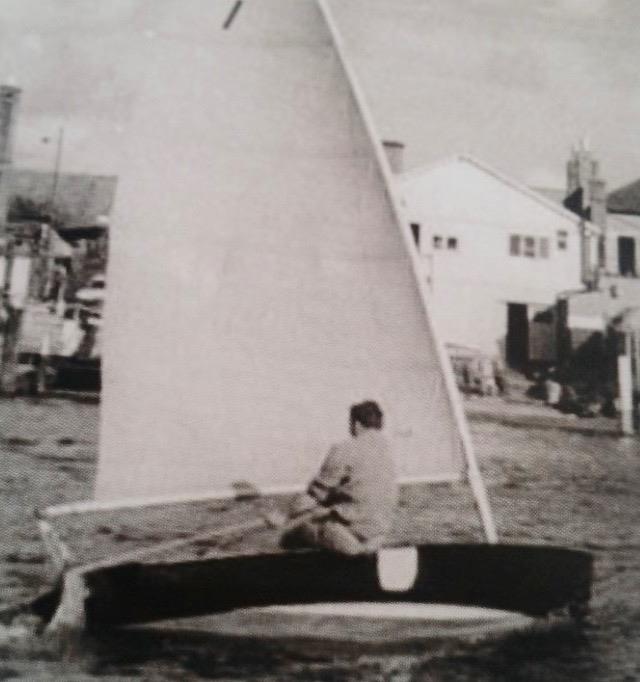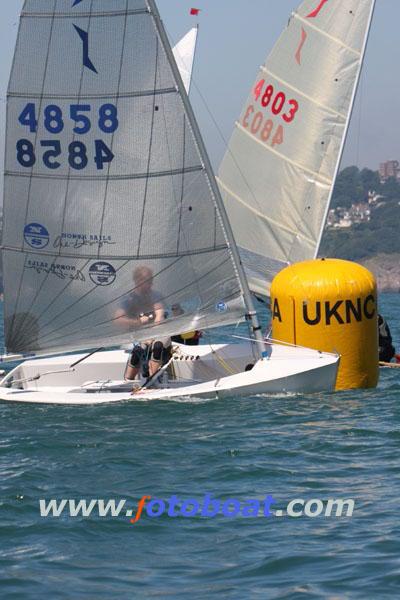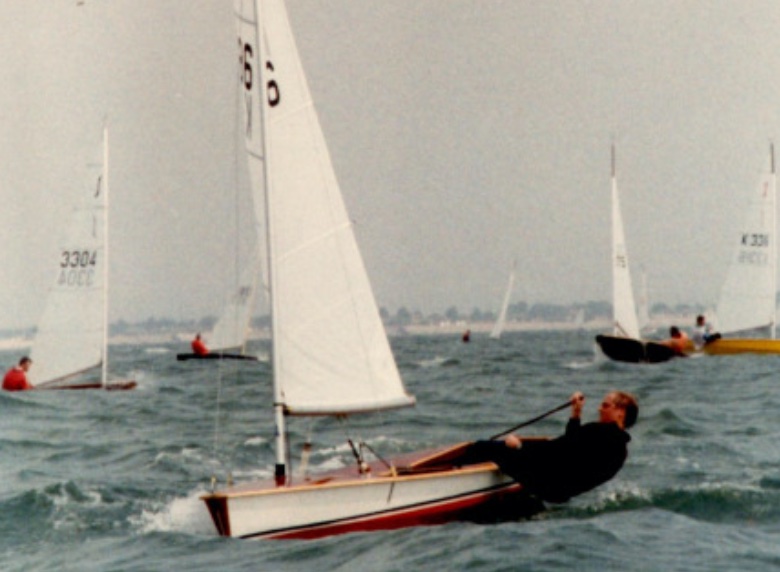Solo, a story by Will Loy
- nigeldavies136
- Dec 19, 2024
- 8 min read
The 2025 Solo Season
I always look forward to Christmas as it is the only time it is socially acceptable to eat in excess, the rest of the year I spend justifying my portion size and frequency of consumption to my inner voice, I am way past caring what other people think. Fortunately, the Solo, a bit like a thoroughbred race horse, has gone through an evolution of carefully orchestrated development, producing a racing dinghy whose underwater shape can lend itself to even the heaviest jockey.

Above Photos;
Lovett Geoff Carveth made great use of the flared gunwales in Bungler 3286,
Gordon Barclay's immaculate Gosling.
Solo 66 complete with washboards and transom sheeting.
The Boon/North package in the hands of Charlie Cumbley.
Alec and his partner Kath at Salcombe, Note the Spruce spars.
Solo 1 being tested on the river at Putney.
It’s all in the Rocker
Back in 1956, Jack was waving his wand over the 12 foot 5 inch Solo and had cleverly built in a plus and minus tolerance of 5 millimetres to all the measurements to allow for home builder error. I ran the tape measure over my father’s Jack Holt Solo 186 (1960) a few times and the numbers were pretty much right down the middle, testament to the great man’s skills as a carpenter and his adherence to the Class rules. I also had the opportunity to own a Solo 1102 (1970) built by the great Alec Stone and the measurements were right on the max and mins at many of the stations with a rocker that was much flatter.
Although all of the NSCA Chief Measurers protected the rules and dimensions with the resolve of the Knights of the Templar, the tolerances, a bit like a a sneaky back door into a computer program would eventually, as builders started to understand the complexities of hydrodynamics, be exploited in the quest for speed advantage and commercial gain.
Stations?
Ok, a brief 101 of the Solo measuring process. The Solo hull is divided up into 5 stations, station 1 is around about where the bulkhead is, 5 is at the transom. The all-important Datum Line is set from a few centimetres above the transom with the boat inverted, to a point above the foremost point of the bow. So if you have got a few spare hours and are fascinated to see what sort of shape hull you have you can measure both depth of rocker and width of beam at the various stations….or I guess you could look at your RYA measurement form instead.
Seven Decades of Careful Development
Some of the greatest developments included;
The Solo is well known and much berated for its centreboard capping but back in 1956, hiking straps had not been invented so the toe holes in the generously wide case top were very useful. I would hazard a guess that by 1960, hiking straps would be in wide circulation.
The capping was still useful though to lock your foot under when it was a bit fruity and the toe holes provided good hand-holds when pulling yourself in after a capsize.
The Solo was originally rigged with transom sheeting but it would soon convert to a central position, the thwart providing a perfect base for a traveller.
Initially without kicker, one was soon employed in the form of a drum system attached to the front of the case from which a wire would be attached to the boom and tensioned. This was followed in the 70's by a kicking lever, the 80's saw multiple block systems and now we use a cascade of ridiculously strong aramid.
Early 70’s -The Solo Class Association allow construction in GRP and this includes the construction of a composite GRP hull/Timber deck. Sales of Seamark Nunn plastic Solos went through the roof.
Alloy spars are approved and the Needlespar becomes a popular choice.
Mid 70’s - Richard Lovett produces a hull with flared gunwales, providing a more comfortable hiking experience.
Early 80’s - Bob Beckett drops the centreboard case into the hog, historically it was glued and screwed on and prone to failure.
Foam sandwich construction is approved, the 70’s GRP hulls were soft and prone to water ingress but the product is still greeted with some distain, wooden construction would remain prominent.
Mid 80’s - Simon Cray win the Nationals in 1984 in an Uttley built Solo with a mast that has a dramatic amount of rake. Tony Thresher is quick to exploit the bulkhead measurement, tilting it forward at the floor to accommodate more mast rake. let’s remember it was generally built at station 1, 3050mm from transom, the latest tuning guides recommend as much as 3075 from transom to front of mast. Tony is also responsible for reversing the elliptical shaped rudder blade in its stock, bringing the lateral resistance forward and reducing weather helm in doing so.
Early 90’s - Kevin at Gosling Dinghycraft produce a wooden Solo which is both fast and beautiful, setting a benchmark for the mass of builders in the Solo business.
Mid 90’s Severn Sailboats are instrumental in pushing changes to allow composite Solos to look more like their wooden counterparts, lining the case sides with a veneer is just one of the ideas that is legalised.
Max bottom panel thickness in cockpit is increased to 15mm, it was generally built from 6mm ply and necessitated the addition of floor battens to stiffen it.
Epoxy fillets are introduced and this negates the need for bedlogs and knees which had supported the capping and transom.
The Thresher double skinned hulls set the standard in smooth uncluttered cockpits and also allowed Tony to build his hulls in a female mould, incorporating epoxy fillets.
Robin Webb finally gets his rule proposal to allow T terminals for rigging approved, it took him about five years!
Tony Thresher’s proposal to allow aluminium rudder stocks is once again denied!
Late 90’s - Sheathing of foils is allowed but no exotic materials can be used.
Carbon tillers and extensions are permitted and 3 kgs of wooden correctors are replaced with 3 kgs of lead, reducing the demand for the heaviest timber known to mankind and saving the rainforests from decline.
2000 - Dave Winder at Winder Boats and Jim Hunt at Purple Marine introduce the MK1 FRP Solo/Cumulus/Purple sail and within 3 years, annual sales of the off-the-shelf product top 100.
Mid 2000’s - Speed Sails (now the Winder MK2) and subsequently Boon Boats (now Gingerboats) and JP Boats (now owned by P+B) obtain the necessary builders license to build in FRP and these all win Championships but Winder Boats is still the market leader and continue to set the standard. Synergy Marine and GOAT Marine are the latest to build Solos and all have evolved from their wooden counterparts which were created from the minds and hands of those pioneering builders of the 60’s, 70’s and 80’s.
Each build has its own trait, rocker depth, beam width are well documented and the choice enables the helm to pick the shape most suitable for their weight and where they sail, be it on a lake, river, estuary or Sea.
Masts and sails have also evolved in time. A mast tip weight was introduced in the late 80’s as many masts were found to be lighter than allowed, this resulted in a great game of trying to affix a small piece of lead at a balance point inside the extrusion. The tip weight rule was finally dropped in the early 2000’s and these days many masts have inner sleeves which put them on or above the min weight anyway.
The introduction of laminates was actually allowed back in the eighties but Dacron was still favoured until the Boon off-the shelf product, complete with North ST1 ODL hit the market in 2008. Carbon battens quickly followed and while not universally favoured, provide owners with choice, something which has provided the perfect platform for inclusivity, whether male, female, tall, short, fat or thin. It is also perfect for everything in between.
Ultimately, the Solo has evolved gradually as construction processes and materials have improved, maintaining a position in the marketplace as a competitive single handed racing dinghy. The outline of Jack Holt’s Solo remains almost identical, the minimum weight of 70kgs is unchanged for nearly 70 years and the ethos of close one-design racing in this lively little racing dinghy is as strong as ever.
Reasons to be cheerful Part 1
The NSCA team have been burning the Gingerbread scented candles late into the night in their quest to make sure every little boy, girl and other get the opportunity to race their Solos at a local sailing club, the result is a list of venues nearly as long as the big man’s travel itinerary, though he wins on the International front.
With fleets of varying strengths at most of the clubs across the UK, the struggle for our Scottish, Northern, Midland, Eastern, Western and Southern Reps is choosing which venues should be included in the Area Series. A naughty or nice list would make things easier but to be fair, every club are super friendly, every venue provides varying challenges and though there are always favourites, every club should get a fair shout at getting the Solo Circus to come and visit.
While the bigger venues offer facilities some clubs can only dream about, bars that overlook the race area, slipways wider than the M25 and water which is devoid of sewage overflow, the entry fee can sometimes be on the steep side, such is the nature of the privately run club.
Alternatively, some of the real grass root venues are at the end of pot-holed ‘roads’, have one shower, no bar and empty milk containers for marks but the hosts make home made Lasagna, bake cakes and raid their drinks cabinets, all for less than £20. The great thing about the UK dinghy scene is that it caters for everybody and there is a club near you which will suit your requirements though to clarify, no-one wants to sail in sewage.
The Area Series have now been confirmed and are published in the Events section of the Solo Webpage so it is time to spend a little bit more on your partner, do some domestic chores and earn those hall passes in these winter months. If you are single then treat yourself to that piece of sailing apparel and pencil in those 2025 venue dates you really want to try.
Reasons to be cheerful Part 2
The North Sails Super Series has been going strong for 9 years and takes the participants on a journey to some of the bigger waters in the UK and includes all our big major events including the Nationals, Nation’s Cup and Inlands. Qualifiers get the chance to win a huge discount on a North Sail but most importantly, it is a test against the finest Solo athletes, so a benchmark to how good you are and how much better you want to get.
The NSCA have for ever, recognised that welcoming elite sailors into the fleet and by that I mean Sailmaker, Boatbuilder and Hardware specialists, improves the products we use, increases development of hulls, sails and hardware and best of all, raises the standard of Solo sailing across the whole fleet. I would also say it adds ‘kudos’ to the Solo Class, to win, first you have to beat the best.
I have been fortunate in my lifetime to race against Carveth, Hunt, Falcon, Batt, Payne, Moffett, Davis, Cumbley, Lea and Howard, all great Champions and my life has been richer for it. My Dad raced against the likes of Conway-Jones, Stone, Gates and Rockett, another era in the tapestry of the Solo Class but the ambitions remain the same, we all want to race against the best.
The Super Series offers opportunity to test yourself and improvement is inevitable.
Reasons to be cheerful Part 3
The two hottest tickets are for the Nation’s Cup, being held on Lake Como June 21-25 and the National Championship Aug 3-8, a totally different bunch of conditions, the only constants being the language barrier and its on water.
Our Dutch friends are organising the Como event and they are running hot at this time with a Solo fleet with strength in depth and height, they also know how to put on a show so it should be fabulous and memorable. Can the UK reclaim the title and if so, who?
The National Championship is being held on the same week as the Fringe Festival so there will be a great vibe and plenty for partners to do while we battle for the title at North Berwick. Last time we were there in 2015 it was positively balmy and with global warming only going one way, I anticipate a hot event.
So, get yourself a Solo, earn those brownie points and get ready for an action packed Solo season.
Will Loy













Comments